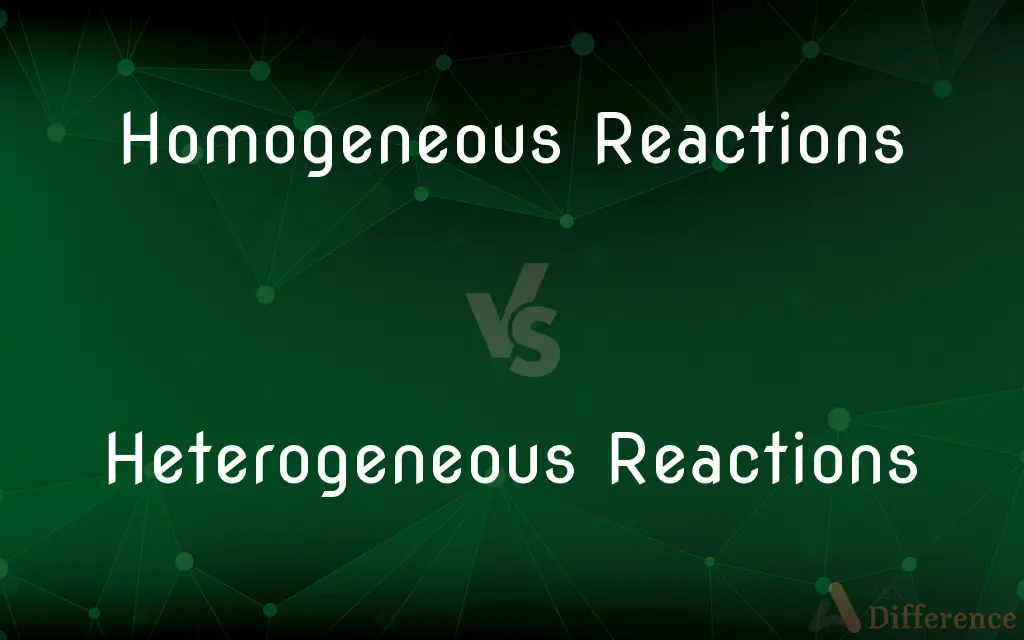Homogeneous Reactions vs. Heterogeneous Reactions — What's the Difference?
By Tayyaba Rehman — Published on January 3, 2024
Homogeneous reactions occur in a single phase with reactants uniformly distributed, while heterogeneous reactions involve reactants in different phases, typically at an interface.

Difference Between Homogeneous Reactions and Heterogeneous Reactions
Table of Contents
ADVERTISEMENT
Key Differences
Homogeneous reactions involve reactants that are in the same phase, such as all gases or all liquids, leading to a uniform distribution of molecules. This uniformity allows for consistent interaction among reactants throughout the reaction mixture. In contrast, heterogeneous reactions involve reactants in different phases, like a gas reacting with a solid, or a liquid with a solid. The reaction occurs at the interface between these phases.
In homogeneous reactions, the rate of reaction is often influenced by factors like concentration, temperature, and pressure, which affect the entire reaction medium uniformly. On the other hand, heterogeneous reactions are significantly influenced by surface area, as the reaction occurs at the interface. Greater surface area can lead to a faster reaction rate.
Catalysts in homogeneous reactions are in the same phase as the reactants, which allows for easy mixing and interaction. In heterogeneous reactions, catalysts are often in a different phase. For example, a solid catalyst might be used to accelerate a reaction between gases, with the reaction occurring on the catalyst's surface.
Homogeneous reactions are typically found in solution chemistry, where all reactants are dissolved in a single solvent. Heterogeneous reactions are common in scenarios like industrial catalysis, where gases might react over a solid catalyst, or in environmental processes like the interaction of pollutants with solid surfaces.
Monitoring and controlling homogeneous reactions can be more straightforward due to the uniformity of the reaction medium. In contrast, heterogeneous reactions may require special techniques to analyze and control the reaction at the phase boundaries.
ADVERTISEMENT
Comparison Chart
Phase of Reactants
Same phase (e.g., all gases or liquids)
Different phases (e.g., solid-gas, liquid-solid)
Reaction Location
Throughout the mixture
At the interface of different phases
Influence Factors
Concentration, temperature, pressure
Surface area, phase boundary characteristics
Common Examples
Acid-base reactions in solution
Gas reactions on solid catalysts, dissolution of solids
Rate Determination
Uniform reaction conditions
Surface phenomena and phase interaction
Compare with Definitions
Homogeneous Reactions
Single-phase catalysts
Catalysts in homogeneous reactions are in the same phase as the reactants.
Heterogeneous Reactions
Surface-based reactions
Catalytic hydrogenation over a solid catalyst is a heterogeneous reaction.
Homogeneous Reactions
Solution reactions
Sugar dissolving in water undergoes a homogeneous reaction.
Heterogeneous Reactions
Different phase reactions
The reaction between iron and sulfuric acid is a heterogeneous reaction.
Homogeneous Reactions
Uniform medium interactions
In a homogeneous reaction, reactants uniformly interact in a single phase.
Heterogeneous Reactions
Interface reactions
A gas reacting with a liquid surface exemplifies a heterogeneous reaction.
Homogeneous Reactions
Same-phase reactions
The reaction of hydrochloric acid with sodium hydroxide is a homogeneous reaction.
Heterogeneous Reactions
Surface area dependency
The rate of a heterogeneous reaction often depends on the surface area of the solid phase.
Homogeneous Reactions
Consistent condition dependency
Temperature uniformly affects the rate of a homogeneous reaction.
Heterogeneous Reactions
Phase boundary interactions
In a heterogeneous reaction, reactants interact at the boundaries of different phases.
Common Curiosities
Can a reaction start as homogeneous and become heterogeneous?
Yes, especially if a new phase forms during the reaction.
Are homogeneous reactions faster than heterogeneous?
Not necessarily; reaction speed depends on various factors beyond phase uniformity.
Is surface area crucial in homogeneous reactions?
No, surface area is more critical in heterogeneous reactions.
Can catalysts be used in both reaction types?
Yes, but their phase relative to the reactants differs.
Are all solution reactions homogeneous?
Generally, yes, if all reactants and products are in the same phase.
Are solid-solid reactions considered heterogeneous?
Yes, as they involve distinct solid phases interacting.
Are biological enzymes in cells part of homogeneous reactions?
Generally, yes, as they often function in a single-phase environment.
Do temperature changes affect homogeneous reactions uniformly?
Yes, temperature impacts the entire reaction medium evenly.
Can phase transfer catalysts make heterogeneous reactions homogeneous?
They can facilitate interactions between different phases more effectively.
Do heterogeneous reactions occur in everyday life?
Yes, like rusting of iron or cooking on a stove.
Can the same reaction be both homogeneous and heterogeneous under different conditions?
Yes, depending on factors like temperature, pressure, and concentration.
Is gas-solid adsorption a heterogeneous reaction?
Yes, as it involves interaction at a gas-solid interface.
Are homogeneous reactions easier to control?
Often, due to uniform conditions throughout the reaction medium.
Can mixing methods impact homogeneous reaction rates?
Yes, as thorough mixing ensures uniform reactant distribution.
Is filtration more common in heterogeneous reactions?
Yes, to separate products from different phases.
Share Your Discovery

Previous Comparison
Aerobic Respiration vs. Anaerobic Respiration
Next Comparison
Optometry vs. OptologyAuthor Spotlight
Written by
Tayyaba RehmanTayyaba Rehman is a distinguished writer, currently serving as a primary contributor to askdifference.com. As a researcher in semantics and etymology, Tayyaba's passion for the complexity of languages and their distinctions has found a perfect home on the platform. Tayyaba delves into the intricacies of language, distinguishing between commonly confused words and phrases, thereby providing clarity for readers worldwide.














































